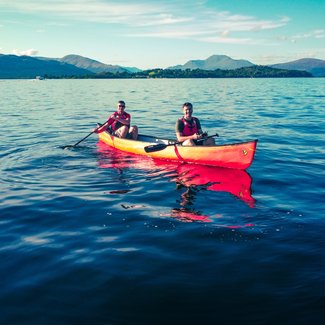Lochs are a defining feature of the Highlands. Whilst they appear throughout Scotland, they are undoubtedly most numerous in the Highlands and are one of the features that have become synonymous with the area.
There are so many lochs in Scotland that we've got a separate article about them!
Some of the most famous lochs in the Highlands include Loch Ness (home of the legendary monster...or is it?) and Loch Lomond (whose bonnie banks are the subject of a well-known traditional song), but there are so many more of comparable beauty that it's difficult to do them all justice!
Lochs can be standing bodies of fresh water or tidal inlets called sea lochs, which are particularly numerous on the Scottish west coast. There are over 31,000 freshwater lochs and lochans in the whole of Scotland, and more than 100 sea lochs.
When is a loch a lochan? And when is it a reservoir?
Well, we aren't completely sure! Generally a lochan is the name used for a smaller body of water that doesn't 'qualify' as a loch. Who qualifies it? Interesting question. Sir John Murray and Laurence Pullar conducted a survey (published in 1910) of lochs and lochans and ordered them by volume, area and length, however this was not - and did not claim to be - exhaustive.
Reservoirs are usually distinct from lochs in that they are created either partly or entirely by some human intervention. However, even here the waters (pun intended) get muddied as reservoirs can come to exist through modifications to pre-existing lochs, and in some of these cases, the name 'loch' or 'lochan' is still used.
When is a loch a firth? And where does the sea end and the loch begin?
Again, great questions which lack a universally-agreed answer. A Firth is usually smaller than a sea loch, as a general rule, and often formed through glaciation along or close to riverbeds (but so are quite a few lochs...). 'Firth' is widely used in Orkney and Shetland to refer to inlets similar to those which would be known as lochs elsewhere in Scotland, which doesn't help the confusion. Firth is also more commonly used on the east coast of Scotland than the west, except that the Firth of Lorn is on the west coast...make sense? We didn't think so!
As for the transition from sea to loch, or indeed loch to river, this is far from clear. Locally-accepted definitions or common linguistic usage often differ from either the Ordnance Survey map or any attempt at scientifically-sound demarcation.
Does it really matter? Not for your enjoyment of lochs or the Scottish Highlands in general, but we're sorry we can't give a better answer!
Which lochs should I visit?
Honestly, it depends what you enjoy!
If size matters, the biggest freshwater lochs (according to Murray & Pullar's survey referred to above) are Loch Ness, Loch Lomond, Loch Morar, Loch Tay, Loch Awe, Loch Maree, Loch Ericht, Loch Lochy (yep, really...), Loch Rannoch, Loch Shiel, Loch Katrine, Loch Arkaig and Loch Shin. Larger sea lochs include Loch Etive, Loch Creran, Loch Nevis, Loch Linnhe, Loch Fyne, Loch Long (which is...long, but by no means the longest sea loch), Loch Hourn and Loch Broom.
- Best for watersports? Lots to choose from but Loch Ken in Dumfries & Galloway takes some beating. Visit Galloway Activity Centre for equipment and instruction.
- Best for drama? Probably Loch Etive on the west coast, which has a tidal falls under Connel Bridge called the Falls of Lora, which in certain conditions turns from an innocent-looking area of flat calm water to a torrent of white water that draws kayakers from across the world.
- Best for fishing? Loch Drunkie or Loch Maree.
- Best for seafood? Loch Fyne, especially for oysters.
- Best for archaeology? Loch Tay, where you'll find the Scottish Crannog Centre.
- Best for castles? Loch Awe, home to the famous and incessantly-photographed ruins of Kilchurn Castle.
- Best for boat cruises? Loch Lomond. Also the best loch for seeing wallabies, incidentally...
- Best for monsters? Well...Loch Ness, of course!



